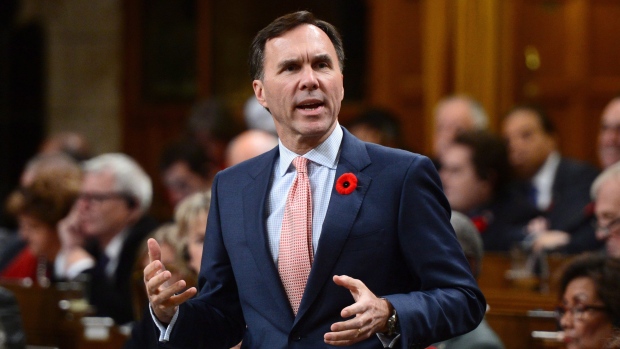Oct 31, 2016
What to expect from Finance Minister Morneau's fiscal update
By Greg Bonnell

With Canadians in the mood to save what was supposed to be stimulus cash for the economy, Finance Minister Bill Morneau will likely lean on infrastructure to fuel his fall fiscal update Tuesday.
Shovels in the ground and enhanced child benefits were two pillars of the spring budget, and both announcements were aimed at helping to kick start sluggish growth.
More than half-a-year later, Canada’s economic prospects have been written down – infrastructure projects take time, and debt-laden families aren’t spending those fatter cheques.
Tuesday’s fiscal update – essentially a mini-budget – will try to assure Canadians Justin Trudeau’s Liberal government is on the right track, despite the apparent lack of economic progress.
At least one economist says Morneau needs to compensate for the family benefit failing to boost consumer spending – to the tune of $5 billion in extra infrastructure funding this year, and $10 billion more for 2017.
“It still remains relatively small in the grand scheme of things but it would be enough to give a little boost in the right direction for the Canadian economy,” Nomura economist Charles St-Arnaud told BNN in an interview.
An infrastructure bank is a likely vehicle for any increased spending on roads and bridges. And the fiscal update gives Morneau a platform to sell the idea to Canadians.
While Ottawa laid out plans for such a bank in its election platform, Morneau’s advisory council raised the stakes in its recent recommendations to boost the economy.
It’s calling for a $40-billion investment from the Liberals in a bid to woo hundreds of billions in foreign investment cash.
Simply put, the hope is an infrastructure bank could attract $4 in foreign investment for every $1 put up by the government.
DEFICITS BIGGER THAN EXPECTED
While Tuesday’s mini-budget could see the Liberals fully endorse the idea by laying out a plan, Canadians will want to know where the money is coming from. There are already multi-billion dollar deficits on the books with no clear path to balance.
Those deficits will be larger than anticipated. The federal deficit is expected to reach $34 billion in 2016-2017, according to a report released last month by TD Economics. That’s $5 billion more than forecast in the original March budget.
Deficits over the next five years are also expected to grow as well. TD said an additional $16.5 billion in debt will pile up over that period as a result of Canada’s economic underperformance. That’s in addition to the nearly $120 billion in deficits originally forecast.
Years of Conservative government fiscal prudence put all the heavy lifting on the Bank of Canada when it came to stimulating the economy.
And with monetary policy running out of steam, Canada’s central banker appears to have little appetite for more rate cuts.
“If we were easing we would not be far away from using unconventional tools – that’s not a decision we would take lightly,” Bank of Canada Governor Stephen Poloz told a House of Commons committee last week.
After all, cheap money has failed to persuade businesses to invest heavily. Families have also piled on so much debt they’d rather save whatever cash Ottawa sends to them.
Almost a year to the day after he was sworn in as finance minister, Morneau will need to show the country there’s a plan to deal with those hurdles – and infrastructure may be his best bet.

